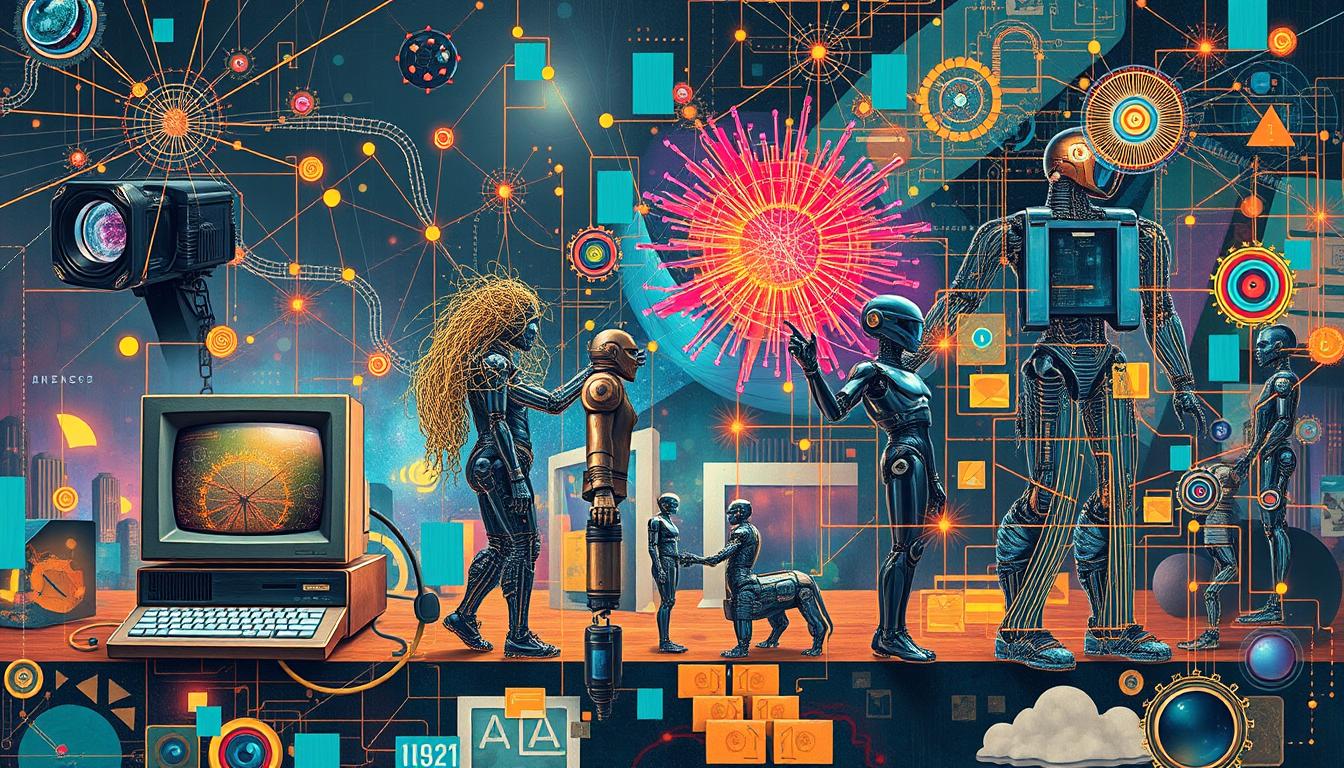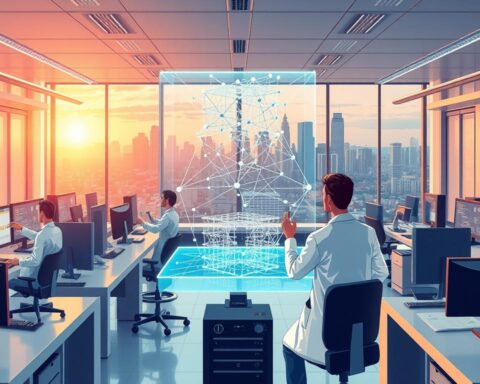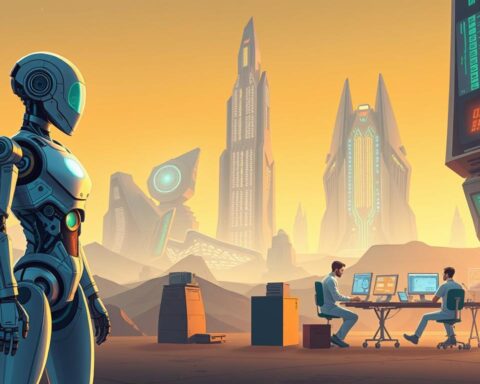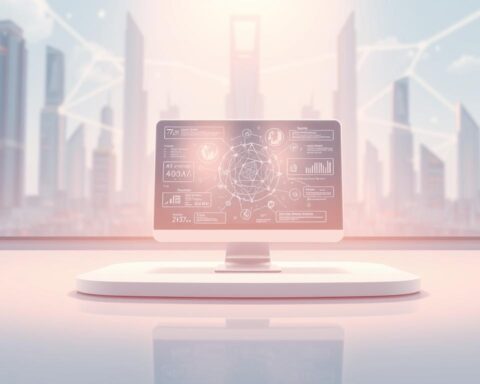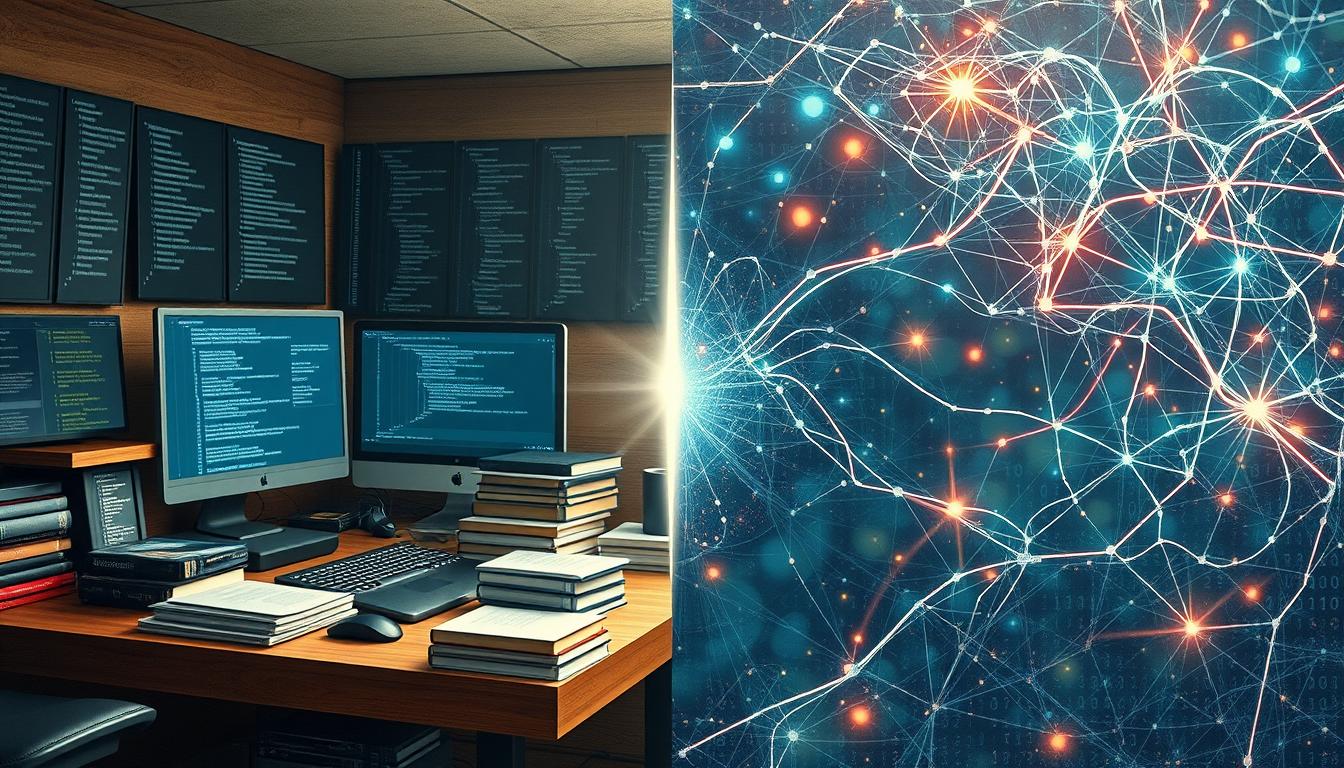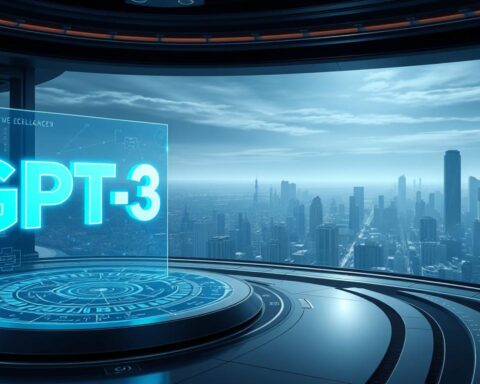Artificial intelligence started in the 1950s. The term “Artificial Intelligence” was first used in 1956 by John McCarthy. This marked the start of a journey that would lead to today’s complex AI1. Over the years, AI has seen many milestones and breakthroughs. These have shaped the field into what it is today2.
Understanding AI’s history is key. It helps us see how AI tools in marketing have changed the game. These tools save time, give better insights, and help make decisions based on data. They also help grow revenue and make campaigns more personal3.
To learn more about AI tools and their uses, check out ai tools for students. It offers insights into AI’s evolution and its effects on different industries.
Key Takeaways
- Artificial intelligence has a rich history dating back to the 1950s.
- The term “Artificial Intelligence” was coined in 1956 by John McCarthy.
- AI tools are being used in marketing to offer time savings, enhanced audience insights, and revenue growth3.
- The evolution of ai has led to significant breakthroughs in various industries.
- Understanding the history of artificial intelligence is key to appreciating its current uses and future possibilities.
- AI-generated content solutions enable scalable content creation, supporting engagement and optimization metrics3.
- Companies using AI in marketing can expect better customer experiences and quick adjustments based on analytics3.
The Birth of Artificial Intelligence: From Concept to Reality
The idea of artificial intelligence has been around for decades. But it wasn’t until the Dartmouth Conference of 1956 that AI started to take shape. This conference, with big names like John McCarthy and Marvin Minsky, is seen as AI’s birthplace4. Ever after, AI technology has made huge strides, with key moments shaping the field into what we know today.
Alan Turing was a key figure in AI’s early days. His work, like the Turing Test, helped set the stage for AI’s growth4. The first neural network, the perceptron model, was created in 19584. These milestones show how far AI has come.
The Dartmouth Conference of 1956
This conference kicked off AI research, aiming to make machines like humans. The goals were high, aiming for machines that could learn and talk to us4. Today, AI has made big leaps, like deep learning and understanding language.
Early AI Pioneers and Their Contributions
Marvin Minsky and John McCarthy were among the first to shape AI. Their work on neural networks and learning set the stage for AI’s future4. The 1980s saw the first expert systems, marking a big step in AI’s journey.
To learn more about AI in different fields, check out case studies in algorithmic thinking. The timeline of AI’s growth shows how fast it’s advancing, with big leaps in recent years.
| Year | Event | Impact |
|---|---|---|
| 1956 | Dartmouth Conference | Birth of AI as a field of research |
| 1958 | Perceptron model | First neural network |
| 1980s | Expert systems | Practical applications of AI |
A Quick AI History Snapshot: The First Wave of Innovation
The 1950s and 1960s saw the first AI programs, like Logical Theorist and ELIZA5. This was the start of AI’s journey. Each step forward built on the last, showing AI’s growth.
Early AI achievements include:
- The first AI program, Logical Theorist, aimed to solve problems like humans5.
- ELIZA, a chatbot, could have simple talks with people5.
- The first AI robot could do tasks like assembly and welding6.
These early steps showed AI’s power to think and learn. They showed humans’ drive to make machines intelligent. For more on AI’s history, check out this link.
AI’s future looks bright, with chances in healthcare, finance, and more. As we improve AI, we’ll see more breakthroughs. These will shape AI’s history7.
| Year | Event | Significance |
|---|---|---|
| 1950 | Development of Logical Theorist | First AI program |
| 1960 | Creation of ELIZA | First natural language processing program |
| 2010 | Introduction of deep learning | Significant improvement in AI capabilities |
The AI Winter and Its Valuable Lessons
The ai winter hit in the 1980s, causing a huge drop in AI funding. It fell by about 90% in the late 1970s8. This downturn was due to unmet expectations and the complexity of AI systems.
Now, AI is back in the spotlight. The global AI market was $3.06 billion in 2020 and is expected to reach $15.7 billion by 20288. New tech like neural networks has sparked renewed interest. Today, 78% of businesses use AI, showing a big shift towards its adoption9.
We’ve learned a lot from the ai winter. It taught us to manage our expectations and understand AI’s complexity. Moving forward, investing in AI research is key. AI can change many industries, but we must know its limits.
For more on AI’s history, check out this link. AI’s history is over 60 years long, with periods of decline and low funding10. By learning from the ai winter, we can ensure AI’s future is bright and beneficial.
| Year | Event | Description |
|---|---|---|
| 1971 | Introduction of the first microprocessor | Led to a computing power increase and cost reduction needed for AI research8 |
| 1985 | Workforce projections | Indicated that AI technologies could potentially automate 45% of current jobs in various industries by 20308 |
| 2020 | Global AI market estimate | Estimated to be $3.06 billion, with projected growth to $15.7 billion by 20288 |
Revolutionary Breakthroughs in Modern AI Development
Modern AI has changed many fields, like virtual assistants and image recognition11. It has also changed how we live and work. Deep learning and neural networks have been key, making systems as smart as humans in tasks like speech and image recognition11.
Machine learning has also made big strides in AI, like generative AI. It can create realistic text and images11. But, we must think about ethics, like in healthcare and justice11. Researchers are working to make AI better and more accessible11.
Some key areas in AI development include:
- Improving AI’s ability to work well in different situations
- Creating models that can handle text, images, and sounds
- Making AI easier for people to use and access
These goals will lead to more breakthroughs in AI. They will change many industries and society11.

The Impact of Deep Learning and Neural Networks
Deep learning and neural networks have made big strides in AI. They’ve led to cool stuff like image recognition and understanding natural language12. These techs are way better at handling complex data than old-school machine learning12.
They’ve quickly become a big deal in banking, insurance, retail, and more12. This is because they help make smarter decisions faster and more accurately12.
Neural networks have layers: input, hidden, and output13. Deep learning uses lots of hidden layers to handle huge amounts of data13. This tech is behind cool stuff like self-driving cars, which learn from over 1 million vehicles13.
The history of neural networks is fascinating. The first AI program, Logical Theorist, was made in 195614. Then, in 1957, Frank Rosenblatt created the Perceptron, a simple neural network14.
Even though the Perceptron had its limits, it opened doors for more advanced networks like the Multilayer Perceptron (MLP)14.
Today, deep learning and neural networks are changing many industries, from healthcare to finance12. As we keep pushing the boundaries of AI and machine learning, we’ll see even more amazing things in the future12.
Conclusion: From Past Innovations to Future Possibilities
The future of ai looks bright, with chances to help in healthcare, education, and energy. It’s key to think about how ai will affect the global economy. By 2035, ai could add $15.7 trillion to the world’s economy15. Countries like China and the US might make up 70% of this impact15.
Recently, ai has made big strides, like generative ai. This tech could boost productivity and innovation by 202416. The success of Deep Learning models depends on hidden layers and data complexity15. As we dive deeper into ai, we must think about its uses and effects.
The future of ai will be shaped by new advancements in machine learning and neural networks. This tech could change many industries and how we live and work. As we wrap up our look at ai’s past, present, and future, it’s clear ai’s possibilities are endless. It will keep playing a big role in our world15.
FAQ
What is a quick AI history snapshot?
A quick AI history snapshot is a brief look at how artificial intelligence has evolved. It covers key milestones, breakthroughs, and progress over the years. This gives a full picture of AI’s growth.
What were the initial goals of AI research?
Early AI researchers, like Alan Turing, aimed to make machines that could think like humans. They wanted these machines to solve problems and make decisions on their own.
What is the significance of the Dartmouth Conference of 1956 in AI history?
The Dartmouth Conference of 1956 was a turning point in AI history. It brought together pioneers like John McCarthy and Marvin Minsky. They discussed making machines that could think and learn.
What is the AI winter, and what were its causes?
The AI winter was a time when AI research lost interest and funding. It happened because early AI goals weren’t met and systems had limitations. This led to a drop in investment and research.
What are the key applications of deep learning and neural networks in modern AI development?
Deep learning and neural networks have many uses today. They power virtual assistants, image recognition, and natural language processing. These advancements are changing healthcare, finance, and transportation, making our lives better.
What is the impact of deep learning on the field of AI?
Deep learning has greatly influenced AI. It lets machines learn from big data and get better over time. This has led to amazing results in tasks like image and speech recognition, and natural language processing.
What are the future possibilities of AI, and how will it transform various industries?
The future of AI looks bright, with many possibilities in healthcare, education, and more. AI will make these industries more efficient and improve customer experiences. This will bring big benefits to the economy and society.
What is the evolution of neural networks, and how have they contributed to the progress of AI technology?
Neural networks have evolved a lot, from early models to today’s deep learning systems. These advancements have allowed machines to learn from complex data. This has been key to AI’s fast progress.
What are the significant ai milestones, and how have they shaped the field of AI?
Important AI milestones, like the first AI program and neural network, have shaped the field. They showed machines can think and learn. This has led to more advanced AI systems and applications.
What is the progress of AI technology, and how has it transformed the way we live and work?
AI technology has made huge strides, with big advances in machine learning and more. It has changed how we live and work by creating intelligent systems. These systems have increased efficiency and brought new ideas to many areas.
Source Links
- Writing and AI in College Education – https://miamioh.edu/howe-center/hwac/resources-for-teaching-writing/writing-and-ai-in-college-education.html
- Creating Flashcards with Generative AI – https://thedarktrumpet.com/programming/2024/01/02/generative-ai-flashcards/
- The Top 10 AI Tools for Marketers (Updated 2024) – https://www.pecan.ai/blog/top-10-ai-marketing-tools/
- History of AI: From Concept to Reality – https://www.internetsearchinc.com/history-of-ai-concept-to-reality/
- These are extraordinary times in the world of AI… – https://medium.com/@marcus_78785/these-are-extraordinary-times-in-the-world-of-ai-55fd2c8a2f87
- The brief history of artificial intelligence: the world has changed fast — what might be next? – https://ourworldindata.org/brief-history-of-ai
- Introducing Copilot+ PCs – The Official Microsoft Blog – https://blogs.microsoft.com/blog/2024/05/20/introducing-copilot-pcs/
- Artificial Intelligence – A History – https://developer.att.com/blog/the-evolution-of-ai
- The mechanisms of AI hype and its planetary and social costs – AI and Ethics – https://link.springer.com/article/10.1007/s43681-024-00461-2
- The Evolution of AI in the USA, 1956-1996 – Technology’s Stories – https://www.technologystories.org/ai-evolution/
- Jan Beger on LinkedIn: This paper provides an overview of AI's history, current state, and future… – https://www.linkedin.com/posts/janbeger_this-paper-provides-an-overview-of-ais-history-activity-7263015375091499008-Ws_H
- Deep Learning and Neural Networks: Decision-Making Implications – https://www.mdpi.com/2073-8994/15/9/1723
- Deep Learning vs. Neural Networks – https://blog.purestorage.com/purely-educational/deep-learning-vs-neural-networks/
- A Brief History of AI with Deep Learning – https://medium.com/@lmpo/a-brief-history-of-ai-with-deep-learning-26f7948bc87b
- What is AI? Types & Examples of Artificial Intelligence – https://www.simplilearn.com/tutorials/artificial-intelligence-tutorial/what-is-artificial-intelligence
- The Evolution of Digital Transformation History: From Pre-Internet to Generative AI | HatchWorks AI – https://hatchworks.com/blog/product-design/history-digital-transformation/
